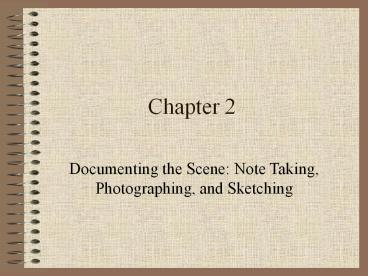Documenting the Scene: Note Taking, Photographing, and Sketching - PowerPoint PPT Presentation
Title:
Documenting the Scene: Note Taking, Photographing, and Sketching
Description:
They accurately represent the crime scene ... details Identify the sketch with a legend and scale ... Materials Uses Drawing Kit Contains tools ... – PowerPoint PPT presentation
Number of Views:216
Avg rating:3.0/5.0
Title: Documenting the Scene: Note Taking, Photographing, and Sketching
1
Chapter 2
- Documenting the Scene Note Taking,
Photographing, and Sketching
2
Field Notes
- Investigative notes are a permanent written
record of the facts of a case to be used in
further investigation, in writing reports, and in
prosecuting the case. - Detailed notes can make or break a conviction.
3
Record Information
- Who?
- What?
- Where?
- When?
- How?
4
How to Take Notes
- Dont include words such as a, and, and the.
- Write legibly.
- Use standard abbreviations such as mph, DWI, and
Ave.
5
Advantages of Photographs
- They can be taken immediately.
- They accurately represent the crime scene and
evidence. - They create interest and increase attention to
testimony.
6
Disadvantages of Photographs
- They are not selective.
- They do not show actual distances.
- They may be distorted and damaged by mechanical
errors in shooting or processing.
7
Commonly Used Photographic Equipment
- 35 mm camera
- Instant print camera
- Digital camera
- Press camera
- Fingerprint camera
- Video equipment
8
Advantages of Digital Cameras
- Elimination of time and expense involved in
developing photographic film. - Quickly adaptable as e-mail attachments.
- Easily incorporated into written reports.
- Record information about each photograph.
- Consistency.
9
What to Photograph
- Long-range pictures of the locality.
- Medium-range pictures of the immediate crime
scene and location of objects of evidence within
the area or room. - Close-range pictures of specific evidence.
10
Photogrammetry
- Refers to the making of 3-D measurements of the
real world directly from photographs for use in
courts. - Can accurately locate and measure any object
appearing in two or more photographs. - Can automatically orient photographs taken from
awkward angles. - Can correct for camera misalignment.
11
Types of Investigative Photography
- Surveillance Photography
- Aerial Photography
- Night Photography
- Laboratory Photography
- Mug Shots
- Lineup Photographs
12
Types of Laboratory Photography
- Microphotography takes pictures through a
microscope. - Macrophotography enlarges a subject.
- Laser-beam photography reveals evidence
indiscernible to the naked eye. - Ultraviolet-light photography uses the low end
of the color spectrum to make visible impressions
of bruises and injuries long after their actual
occurrence.
13
Admissibility of Photographs in Court
- Photographs must be
- Material,
- Relevant,
- Competent,
- Accurate,
- Free of distortion, and
- Non-inflammatory.
14
Crime Scene Sketches
- Accurately portray the physical facts.
- Relate to the sequence of events at the scene.
- Establish the precise location and relationship
of objects at the scene. - Help create a mental picture of the scene.
- Permanent record of the scene.
- Usually admissible in court.
15
Steps in Sketching the Crime Scene
- Observe and Plan
- Measure and Outline the Area
- Plot objects and evidence within the outline
- Record details
- Identify the sketch with a legend and scale
- Reassess the sketch
- File the sketch
16
Plotting Methods
- Rectangular-Coordinate Method
- Baseline Method
- Triangulation Method
- Compass Point Method
- Cross-Projection Method
17
Materials for Making Scale Drawings
18
(No Transcript)































